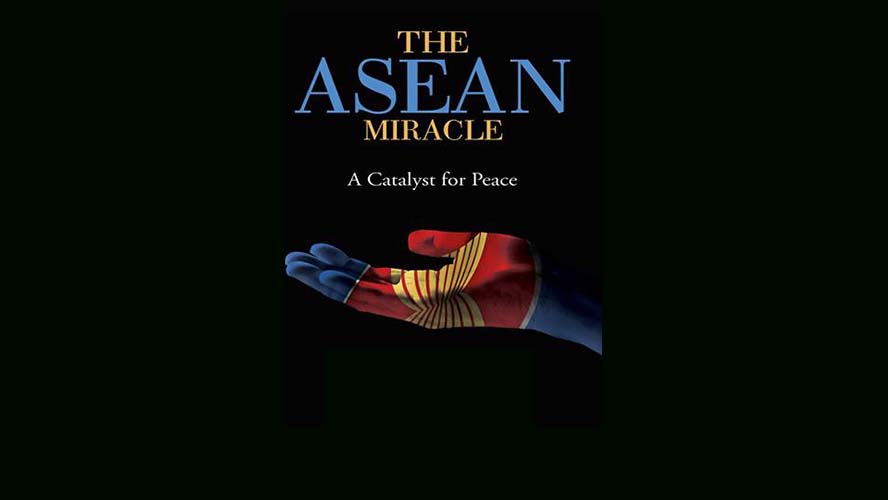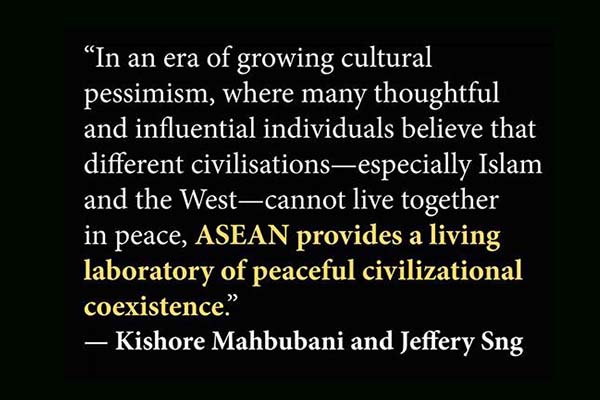Asean provides an important security umbrella for S’pore and the region. People, stop poking holes in this umbrella.

Imagine Singapore in December. The north-east monsoon is approaching. Heavy rains are coming. Someone has gifted you a strong umbrella. The rational thing to do would be to preserve and protect this umbrella. The irrational thing to do would be
to poke holes in this umbrella.
Yet, many Singaporeans today are doing this irrational thing. They have been gifted a wonderful geopolitical umbrella. It is called Asean.
Instead of strengthening it, they are poking holes in it. And they are poking holes just as new geopolitical storms are coming to our region, in the form of enhanced US-China rivalry.
Why are Singaporeans behaving irrationally? The simple answer is ignorance. Any simple survey would show that most Singaporeans know next to nothing about Asean. Many can't recognise the Asean flag.
President of the Institute of Singapore Chartered Accountants Gerard Ee was dead right when he said at a recent panel discussion that Singaporeans should understand the region better. Singaporeans, he said, "do not understand the cultures and values of
different people in the region that we are trying to form a bond with, and we might inadvertently end up making enemies rather than friends. So I wish all the schools would go back to teaching the history of all the Asean countries so that we appreciate
where they're coming from."
Even more sadly, the little that Singaporeans know about Asean comes from the usual jaundiced Anglo-Saxon media coverage of Asean.
To combat this ignorance, a childhood friend of mine, Jeffery Sng (with whom I grew up in Onan Road in the 1950s and 1960s) and I decided to publish a book on Asean to coincide with Asean's 50th anniversary on Aug 8 this year. It is called The Asean Miracle:
A Catalyst For Peace, and it has been published by NUS Press this month. The goal of this article is to provide a flavour of the book.
One simple way of understanding Asean is to apply the 3M formula. 3M here does not refer to the Minnesotan manufacturer of sturdy products. The three "M" words to understand Asean are Miracle, Mystifying and Money.

Asean miracle
Why is Asean a miracle? First, when it was born in 1967, everyone expected it to fail. Its two predecessors, ASA (Association of South-east Asia) and Maphilindo (Malaya-Philippines-Indonesia), died within two years. No one dreamt in 1967 that Asean would
hit 50. But it has.
Second, all the five founding members had bilateral disputes with each other in 1967. Indonesia had confronted Malaysia. Singapore had just had a bitter separation from Malaysia. The Philippines claimed Sabah from Malaysia and the south Thailand insurgency
was brewing on the Thai-Malaysia border.
Third, the region was in turmoil. Communist parties were active. The Vietnam War was gaining momentum. The Tet Offensive took place five months after Asean's birth.
Fourth, South-east Asia is the most culturally diverse region on planet Earth. If you were looking for a place to start regional cooperation, the last place you would pick is South-east Asia. In short, there were many reasons why Asean should have failed.
And I could give a few more. This is why Asean's success is a true miracle.
Fear, not love, broughtAsean together
Yet, this miracle is also mystifying. No one really understands why Asean has emerged as the world's most improbable success story. Our book cannot possibly provide a definitive explanation. Future historians will have to do this. Nonetheless, we try
to provide a theory on why Asean succeeded. This theory is based on a few four-letter words. The first begins with "f ". It is fear.
Why is Asean deprived of resources? The simple answer is that the total size of the Asean budget is determined by the capacity to pay of the poorest member of Asean. This is a result of Asean's insistence on the principle of equal payments from all 10 countries. This principle is manifestly absurd as it says that large and rich member states should pay the same as small and poor member states.
Given the major bilateral disputes they had with each other, it was not love that brought together the five founding members, Indonesia, Malaysia, the Philippines, Singapore and Thailand. It was fear of communist expansion. Indeed, these five countries
were often referred to as the non-communist "dominoes " waiting to fall in the face of communist expansion. As Jeffery and I both lived through this period, we experienced this fear. It was real.
The second four-letter word is luck. Asean was lucky on several counts, especially in the 1980s. After Vietnam defeated the United States in 1975, it became arrogant. It invaded Cambodia in 1978. This triggered a geopolitical alliance between the US,
China and Asean. The three worked closely together. I experienced it at first hand when I served as Singapore's Ambassador to the United Nations from 1984 to 1989. This strengthened Asean considerably. It was geopolitical luck that drew us together.
Asean was also lucky to have unusually strong leaders, especially in the 1980s, including Indonesia's Suharto, Singapore's Lee Kuan Yew and Malaysia's Mahathir Mohamad. Strong leaders don't have to worry unduly about domestic political pressures - they
can focus on doing the right thing for the region. Indonesian leadership was key. Suharto wisely decided that the best way for Asean to grow was for Indonesia to take a back seat. It allowed smaller countries, like Malaysia and Singapore, to play a
stronger role. As our book documents, it was also Suharto who made the fateful decision that Indonesia should join the rest of Asean in opposing the Vietnamese invasion. If Indonesia had vacillated, Asean would not have succeeded. In short, Asean avoided
many potential disasters. It was lucky.
The third four-letter word will make you laugh. It is golf. When I mention the role of golf, many in the West think I am joking. Yet, I am dead serious. Multilateral negotiations are inherently messy. If you want to argue about texts of documents, you
can go on for hours. Yet, somehow, after a golf game with my then Asean senior official counterparts in the 1990s, we would have a beer and reach agreements very quickly. The camaraderie produced by golf did the trick.
One recent miracle Asean achieved was the conclusion of the Asean Charter in about a year in 2007. This achievement should be recorded in the Guinness Book of Records. And how was agreement reached so quickly? Former deputy prime minister S. Jayakumar
was a member of the Eminent Persons Group that was set up to begin the discussions of the charter. In our book, we quoted him as saying: "It helped that Ramos, Ali Alatas, Musa, Jock Seng and I had also been long-time golf buddies! " These were Fidel
Ramos of the Philippines, Ali Alatas of Indonesia, Musa Hitam of Malaysia and Lim Jock Seng of Brunei.
More resources needed
Yet, even though Asean has succeeded in many ways, it continues to face many perils. Our book documents many of these, especially the geopolitical perils. But one peril that it faces can be solved quite easily. This peril is lack of money. For reasons
I still don't fully understand, the Asean Secretariat has been deprived of the resources that it needs to grow to a healthy state.
To understand the scale of the problem, just compare the budgets of the world's most successful regional organisation, the European Union, with the budget of the world's second-most successful regional organisation, Asean. The EU's annual budget was 145.3
billion (S$219 billion) in 2015. Asean's was US$19 million (S$26 million). The EU budget is 8,000 times larger than Asean's. Yet, the combined gross domestic product of the EU is not 8,000 times larger. It is only six times larger.
Why is Asean deprived of resources? The simple answer is that the total size of the Asean budget is determined by the capacity to pay of the poorest member of Asean. This is a result of Asean's insistence on the principle of equal payments from all 10
countries. This principle is manifestly absurd as it says that large and rich member states should pay the same as small and poor member states. Virtually no other credible international organisation (IO) uses this formula. Instead, all credible IOs,
like the UN, use the principle of "capacity to pay ". Rich countries pay more. Poor countries pay less.
This is why one bold recommendation that our book makes is for Singapore to take the lead in arguing for the UN-style "capacity to pay " system to apply to Asean. Why should Singapore take the lead? Singapore should because it is the single biggest beneficiary
of the magnificent Asean geopolitical umbrella. Singapore's trade to GDP ratio is the highest in the world at 300 per cent. No other Asean country came close to this ratio. A lot of Singapore's $1.2 trillion in trade could shrivel up if Asean broke
up and South-east Asia once again became a region of turmoil, as it was in 1967.
This is what I meant when I said that Singaporeans were poking holes in the geopolitical umbrella gifted to us. We should do our best to strengthen this umbrella. Let's start by paying more to it. We can afford it.
This
piece was published in The StraitsTimes on 18 March 2017.